Abstract
HxSTEM is dedicated to serious issues relevant to STEM. Serious issues generate strong—and often contradictory—opinions, which can be divisive, as a number of excellent essays published on HxSTEM illustrate. So we asked ourselves: Is there anything that is both important and non-divisive? Something that could serve as a platform to celebrate our common humanity? The answer is yes, of course, there is such a thing. Let’s talk about cats!
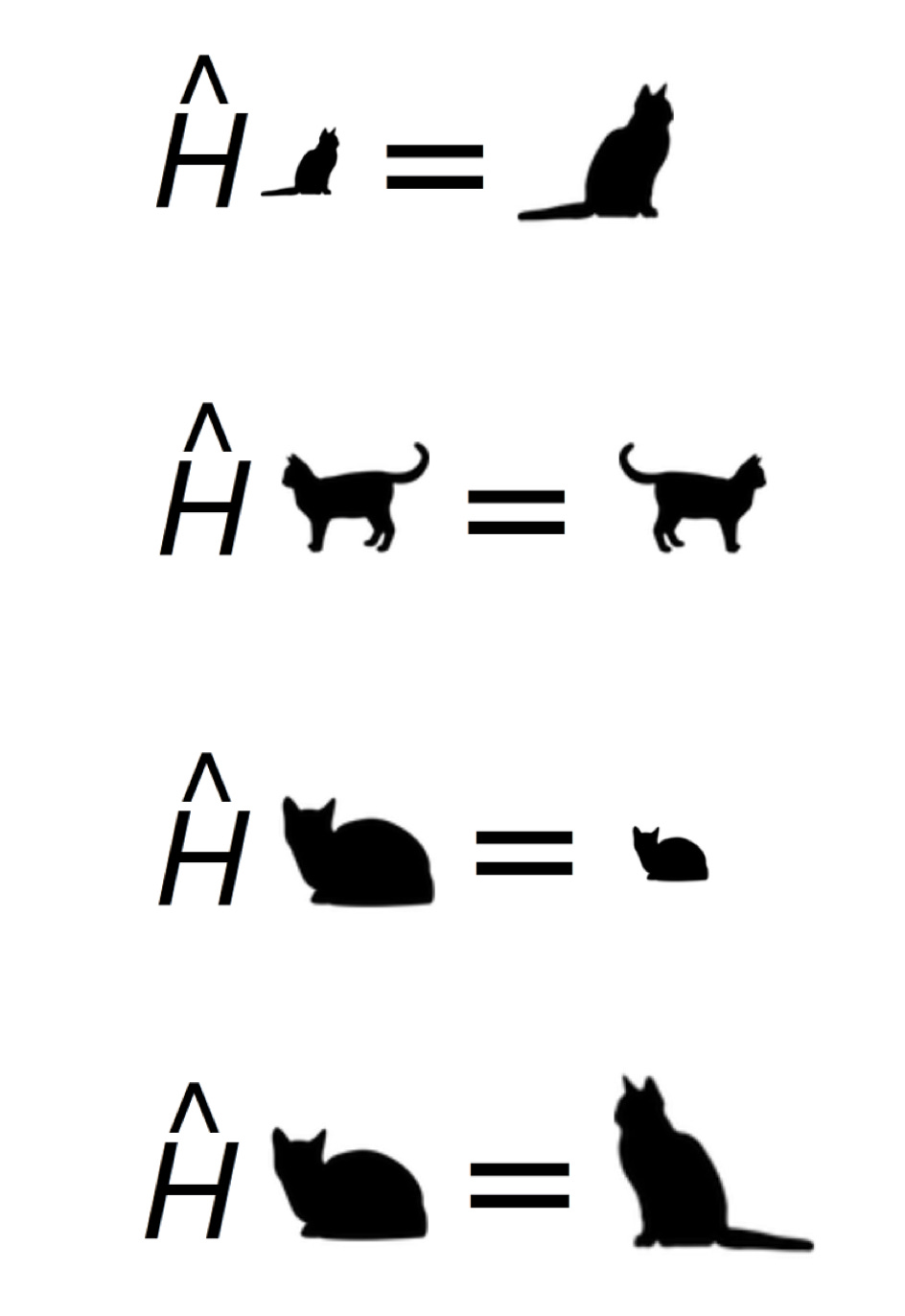
Introduction
I [Anna] love chemistry and cats. They seem to inhabit the same part of my brain—I like to think about cats when I do chemistry, and I like to think about chemistry when I cuddle with my cats. Sometimes cats dominate over chemistry—for example, when I choose to read Jerry Coyne’s weekly Caturday Felid Trifecta [1] instead of doing chemistry. But, overall, my cats make my chemistry better, and that is the main point of this essay. The idea for it came from two of Jerry’s blog posts: Cats Who Owned Famous Scientists and Ten Cats in Literature [2]. So I thought, how about Chemistry with Cats? Indeed, what is the best way to explain complicated and abstract concepts? Of course by using cats! In what follows, we will present a few examples from Anna’s research, in which she used cats to illustrate key concepts. We will conclude with a few words about the real cats in our life and remarks on an important issue of naming a cat.
But, first, we need to acknowledge that we stand on the shoulders of giants, and that cats have been used by scientists to explain important concepts on many occasions. It could, in fact, become a subject of a review article. But today we will mention just one example, the most well-known cat in the history of science communication: Schrödinger’s cat.
The original cat of quantum mechanics
Erwin Schrödinger [3] solved the mystery of the submicroscopic world when he was just 39 years old. In 1926, he wrote down the wave equation, a complete description of the behavior of a quantum system [4]. The equation, which we now call the Schrödinger equation, explained long-standing puzzling observations (e.g., why energy levels in atoms are discrete rather than continuous) and soon became a powerful tool for predicting the properties of more-or-less anything made of nuclei and electrons—molecules, materials, solutions, proteins, plasma, and so on. The Schrödinger equation provides the theoretical foundation for chemistry, molecular biology, material science, and much of physics [4]. It is the most important equation in quantum mechanics. The field of quantum chemistry (Anna’s domain) is dedicated to solving the Schrödinger equation numerically.
So it is not at all surprising that soon—in 1933—Schrödinger’s brilliant discovery was recognized by the Nobel Prize in Physics [5]. Now imagine the state of mind of someone who had just made the biggest discovery of the 20th century and received the ultimate scientific accolade! Imagine the expectations—the scientific community asking what Schrödinger’s next big discovery would be. It could have been intellectually paralyzing. But luckily for Schrödinger, he was fascinated by cats, albeit in a purely theoretical sense (there is no record of him ever having one of his own). And cats came to his rescue.
In 1935, Schrödinger wrote a paper [6] in which he expressed his dissatisfaction with the probabilistic nature of quantum mechanics that followed naturally from his equation. It goes like this: Newton’s mechanics is deterministic, which means that if you know the initial state of the system, then you can predict its precise state at any given time. And that state is well defined—it is concrete. In contrast, the Schrödinger equation gives you probabilities, i.e., how likely it is to find the system in various possible states. But, then, once you actually perform a measurement on the system, that is when you observe some aspect of it, a sort-of miracle happens and you know exactly what state the system is in. The measurement is said to “collapse” the system into a single, concrete state.
In his paper [6], Schrödinger pointed out that the probabilistic nature of quantum mechanics leads to a paradox, which he illustrates with a thought experiment. Imagine a box containing a cat, a vial of cyanide, and a radioactive atom, which has a 50–50 chance of decaying during the experiment. The box is outfitted with a device that is triggered if the nucleus decays. If that happens, the device breaks open the vial, the cyanide is released, and the cat is killed. If, on the other hand, the nucleus does not decay, then the device is not triggered and the cat remains alive.

The paradox is this: Since, according to quantum mechanics, the radioactive nucleus exists in a superposition of two states (decayed and not decayed), the cat in the box must also exist in a superposition of two states—dead and alive—right up to the moment when we open the box and collapse the state of the system into a single, pure state. That is, either the nucleus is non-decayed and the cat is alive, or the nucleus is decayed and the cat is dead. The phenomenon of superposition of states in quantum mechanics is real, confirmed by many experiments, and exploited in technologies such as medical imaging (MRI), sensors (as in GPSs), and the new field of quantum information science (QIS). However, mapping this microscopic superposition of states onto the states of a cat being simultaneously dead and alive creates a paradox [8]: how can an animal be both dead and alive?
Schrödinger’s paper did not contain any new observations or introduce any new concepts, but it stirred the public’s imagination and fascination with quantum mechanics. In his book Schrödinger in Oxford [9], David Clary relates that Schrödinger was a very effective science communicator who gave many public lectures on the topic of quantum mechanics, and that his lectures and writings inspired many young scientists to make adventurous career choices, such as the application of physics to biology (Clary mentions Francis Crick and Maurice Wilkins [9]). Even Einstein was impressed that Schrödinger wrote a serious paper about a cat. Today, Schrödinger’s story of a cat in a box continues to be a crowd-pleaser. Educators around the world use it to ignite students’ interest and lure them into the fascinating, but intellectually demanding, world of quantum mechanics. You can read more about this quantum paradox and various resolutions of it here [8]. The paradox has inspired many artistic renditions, such as this one done in the style of Escher [10]:
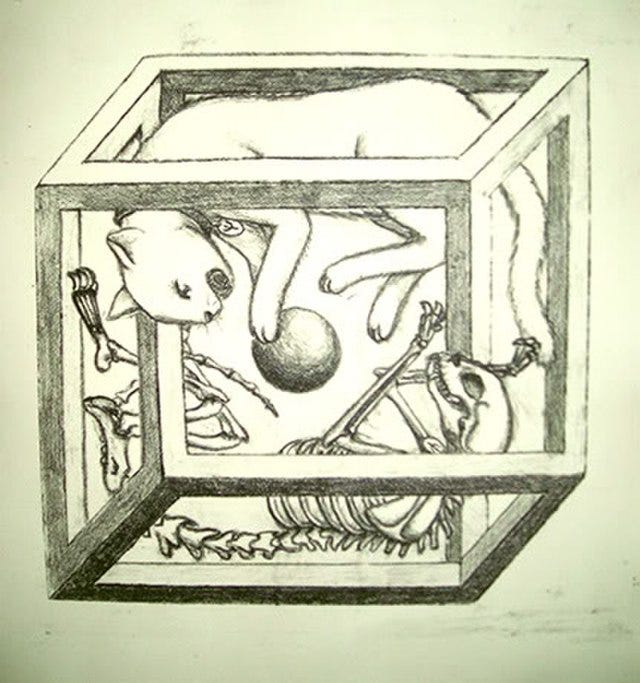
There is even a popular Russian science magazine called Schrödinger’s Cat (Кот Шрёдингера) [11]. Here is the cover of its first issue:
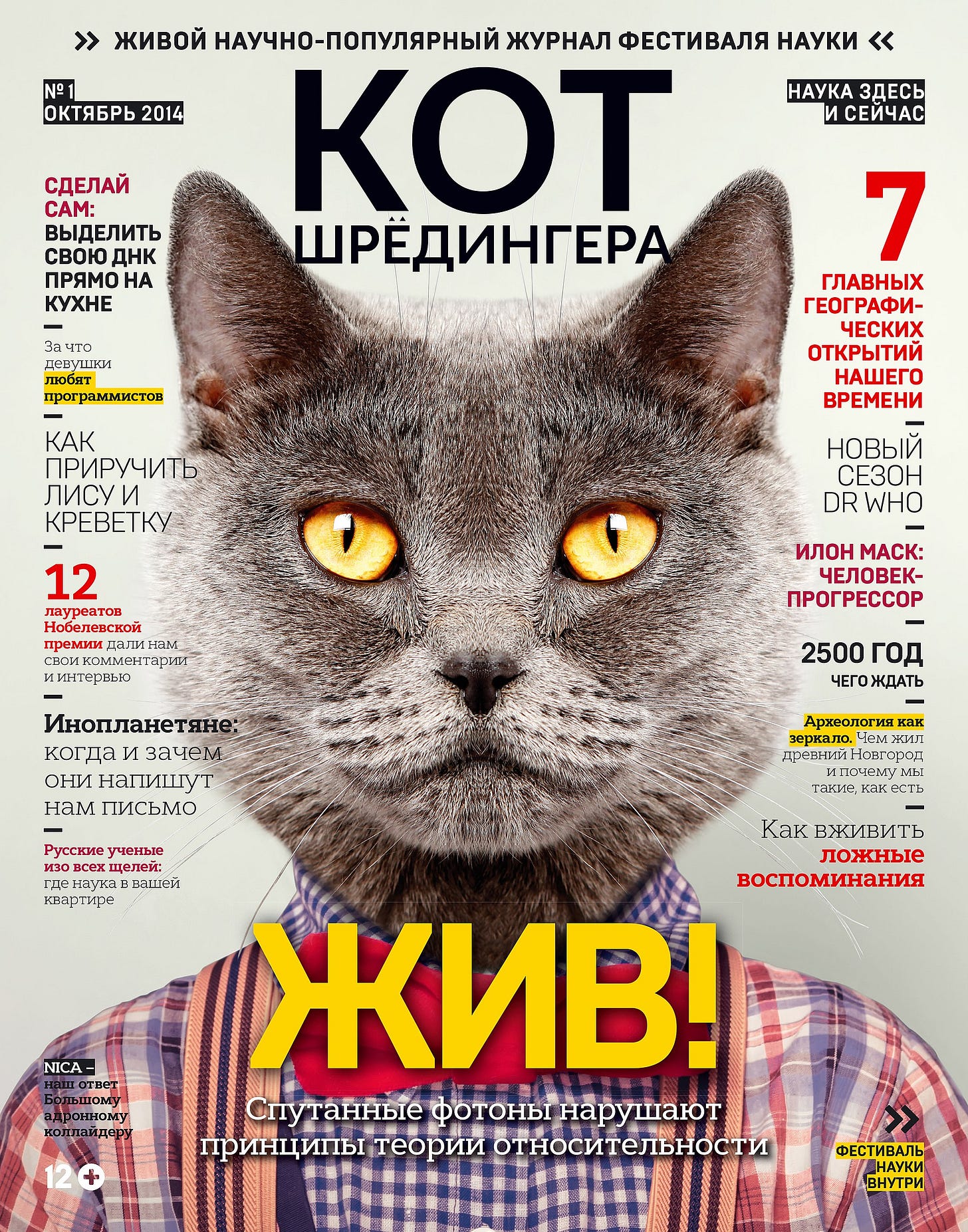
You can find thousands of Schrödinger’s cat images all over the internet. Here is a gallery (courtesy of Kirill Zatrimailov) on facebook that caught our attention [12].
Now that we have acknowledged the original quantum cat, we can move on to more recent examples of cats in quantum chemistry.
Cats in quantum chemistry
Over the years, theoretical chemists have used cats to highlight their work in theoretical chemistry. Below is a compilation of journal covers and other illustrations, with (hopefully useful) explanations. Our first example is the so-called many-body problem.
Cats and the many-body problem
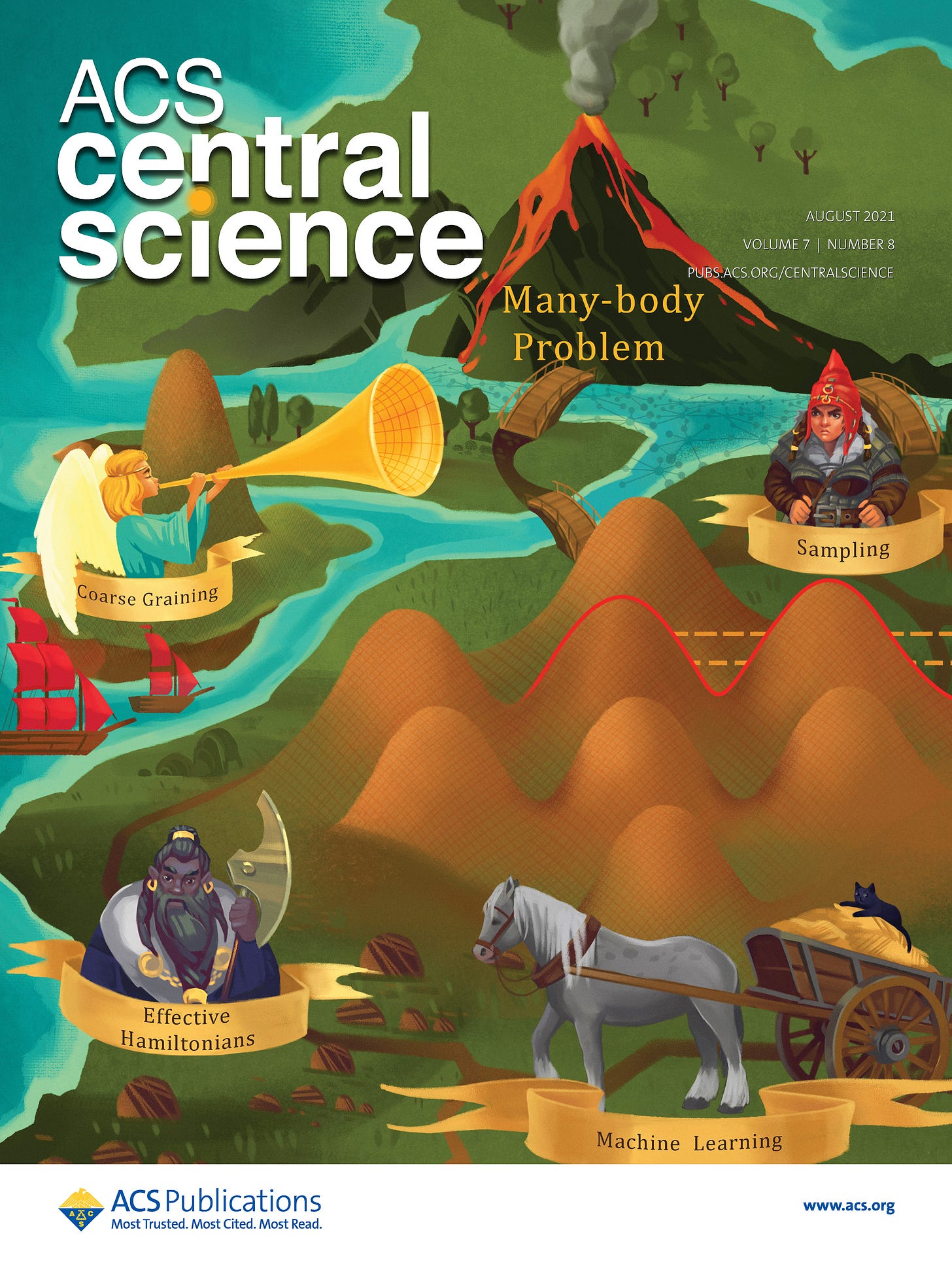
The many-body problem refers to a system of multiple (more than two) interacting particles, for example, a molecule with more than two electrons. Solving the Schrödinger equation for such a collection of interacting nuclei and electrons is hard, and the entire field of quantum chemistry is dedicated to it. Above, is the cover image for a feature article [13] illustrating the complexity of the many-body problem, the challenges in solving it numerically for realistic systems, various means to tackle it, and the potential of machine learning (ML) and artificial (AI) intelligence to help solve these challenges.
Although the cat on the cover is just a free-loader, cats did some serious work in the paper [13]. Below, is a figure from the paper explaining the concept of coarse-graining complexity. The original figure caption reads: “Detailed information about a many-body system, such as a complete description of a cat, with all its hairs and whiskers, can be compressed into a compact form describing a subset of physical properties of the system—an effective cat theory that describes important cat behaviors and informs us when to feed the cat, when to take it to the vet, or how to play with it. This mapping can be done either exactly or approximately. The coarse-grained, effective representation of a cat can be used as a starting point for including more fine-grained descriptions of the system (with more nuanced cat behaviors) or for building up the complexity, all the way up to a multiple cat theory and one for dynamically interacting cats.”
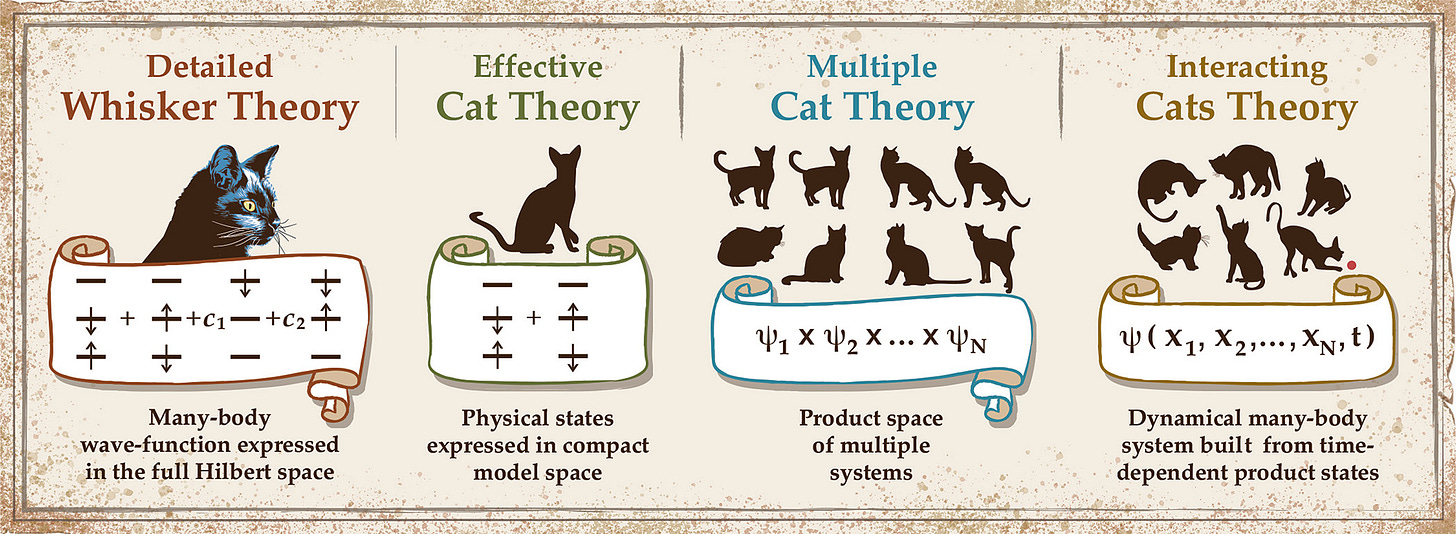
The next figure is from the same paper [13]. It explains various approaches used in physics and chemistry to negotiate the treacherous landscape of the many-body problem. The key challenge is how to get over “the exact many-body wavefunction gorge,” an obstacle separating a computational chemist with a molecular Hamiltonian at hand and the properties of that molecule she is trying to observe. One can build bridges over the gorge—fly over it by various means—or use other innovative technologies, such as a CATapult. Cats are known for their curiosity and their agility—they are ideally equipped to explore the various ways to get around the treacherous gorge. Can you just imagine a dog doing the tightrope stunt, below?
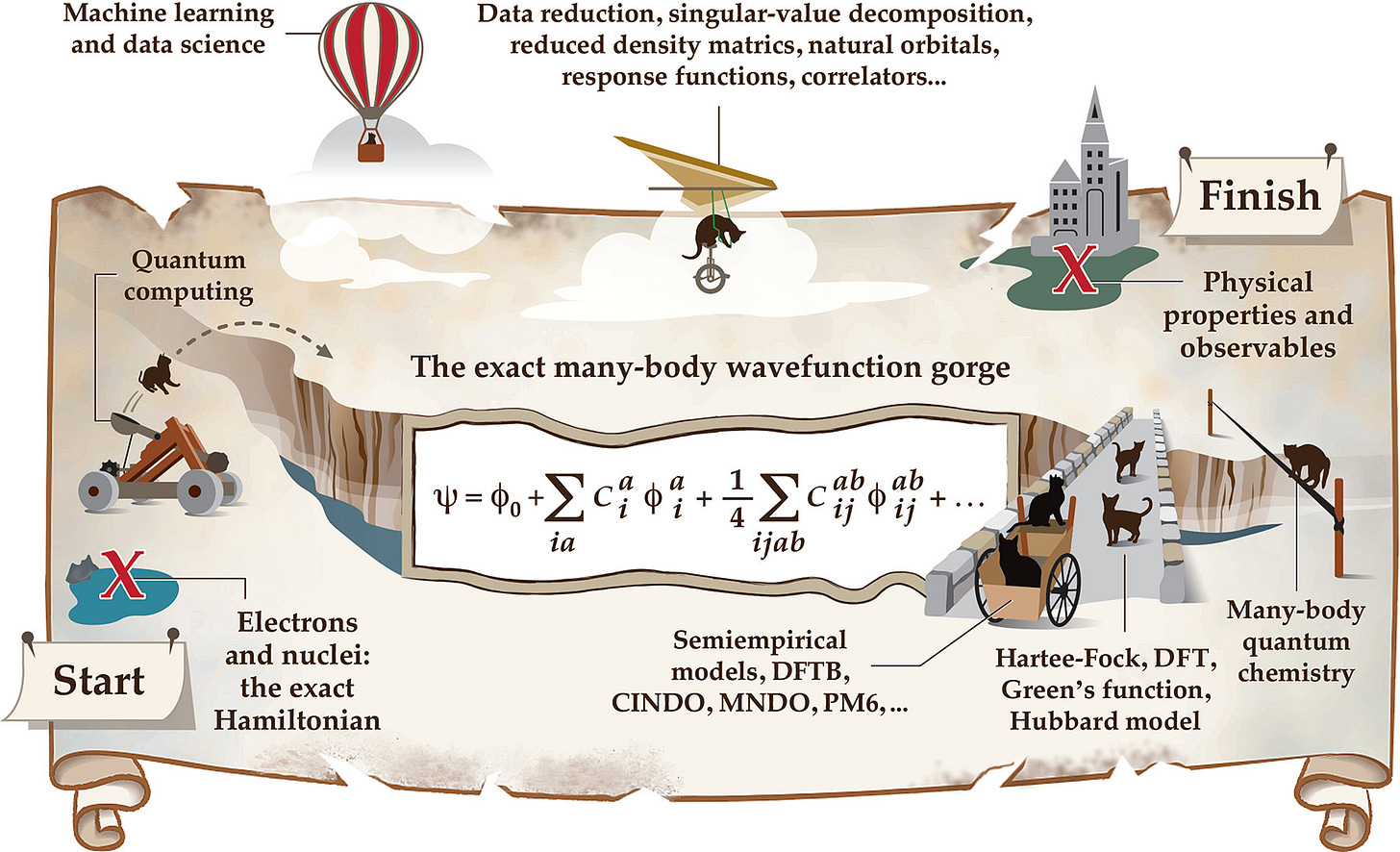
Cats and quantum information science
Quantum information science is a new field, which aspires to use quantum effects for storing and processing information, and even performing computations (quantum computing). The original idea goes back to the physicist Richard Feynman, who speculated [14] that representing quantum equations on a quantum device may prove to be a more effective way of solving them than by representing them on a classical device (a traditional computer). Whether this will indeed be the case remains to be seen, but in the meantime the field is enjoying a windfall of funding, which has attracted many scientists. The essential building block of a quantum computer is the qubit, a quantum system that can exist in a superposition of states, in contrast to its classical analogue, the bit, which can exist in only one of two states: “on” or “off.” Thus, using Schrödinger’s cat to illustrate quantum computing is a no-brainer.
Below, is a cover for a special issue on quantum computing and quantum information science published by the journal Physical Chemistry–Chemical Physics, for which I [Anna] am an editor. It is an accompaniment to the editorial that introduces the topic and summarizes the contributions to the issue: Krylov, Doyle, and Ni, Quantum computing and quantum information storage: An introduction. [15]
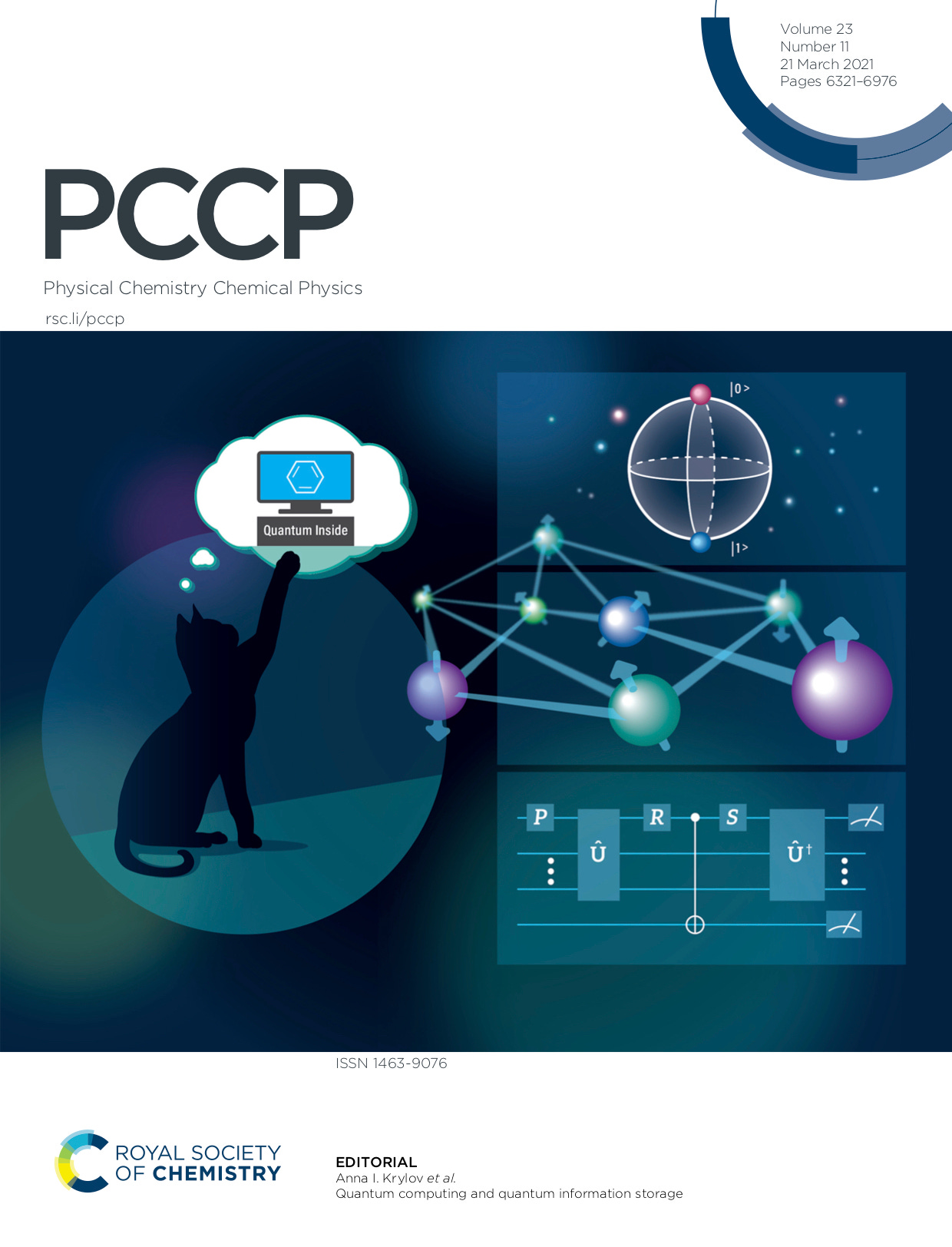
The cover shows a cat dreaming about the wonders that quantum computing could one day deliver. On the right, essential tools needed to realize this dream—a qubit and a quantum circuit—are depicted [15].
The following figure is from the editorial [15]. Its caption reads: “Curiosity-driven fundamental research in physical chemistry and chemical physics has provided a foundation for many transformative technologies (GPS, NMR, etc.) and promises to deliver more. The ability to prepare and control entangled molecular states is the foundation of practical implementation of quantum computing; it may also lead to other, yet unanticipated breakthroughs.”
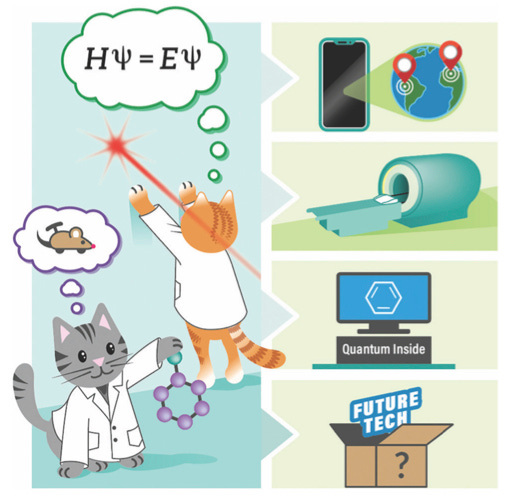
The figure communicates an important message: that we should not be fixated on a particular outcome when we fund research. Many important technological advances, such as those shown on the right, emerged from pure curiosity-driven research and were not anticipated. Thus, it would be detrimental to direct science funding based on expectations of short-term practical benefits or specific technological outcomes. My personal opinion is that funding agencies today tend to overstep their mandates and have become too controlling in determining where money should go. As promising as quantum computing might be, it would be unwise to direct too much money to this specific area, to the detriment of others. Funding agencies should base their decisions on intellectual merit and support fundamental research.
Cats and chirality
This cover illustrates the concept of chirality in chemistry, highlighting new theoretical tools developed by Anna’s lab and her collaborators (Sonia Coriani’s group in Denmark) to probe it [16].
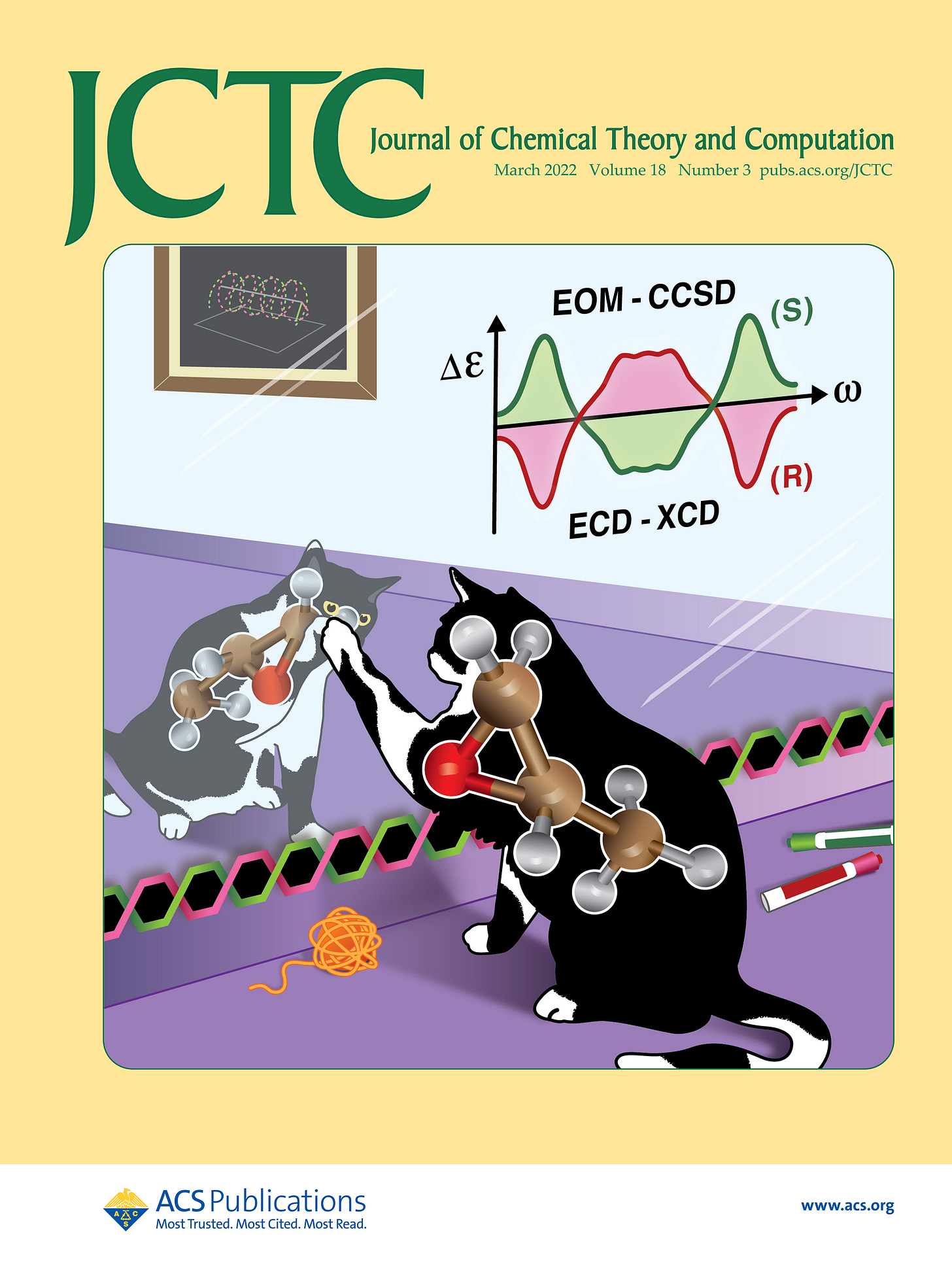
Chirality [17] refers to structures that are not superimposable with their mirror images, such as this cat on the cover and its reflection in the mirror. The chemical properties and most physical properties of chiral isomers (variants of a molecule that are not superimposable mirror images of each other, such as the molecular “skeletons” in the picture) are identical, but they act very differently in biological contexts because most biological systems are chiral themselves. For example, chiral isomers of ordinary sugars taste bitter, chiral isomers of common drugs have vastly different properties, and so on. Therefore, experimental techniques for probing molecular chirality are important, and theory plays an important role in explaining the experimental observations. This is where Anna’s research comes in—she develops computational methods that can simulate the spectra of chiral molecules.
More cats—just for fun
Cat cartoons are useful for explaining virtually any concept. Here are two framed cat-art pictures, which we created as graduation presents for two of Anna’s former graduate students—Natalie Orms and Anastasia Gunina—who share our love of cats. You can read their Ph.D. theses here [18] and here [19] to find out how their research inspired these cartoons.
In the three panels in the above work, cats illustrate states of electrons with different spins and different spin states of many-electron systems. The left panel illustrates the spin-flip method [20] (invented by Anna), in which one describes difficult-to-model low-spin states (such as those with cats with opposite spins) by spin-flipping operators acting on the same-spin state (as the one in the leftmost picture). The spin-flip method has been enjoying ever-increasing popularity, and if you are interested, you can read about it here [20] (but do not expect more cats there).
In the triptych, above, the left panel illustrates the normal distribution, with the mean cat on top, the right panel illustrates random cats, and the central panel illustrates the concept of eigenstates of an operator. An eigenstate of an operator is a state that does not change when acted upon by the operator, except for a change its sign or size (i.e., multiplication by a scalar). The three equations in the central panel illustrate this change in size and sign. The eigenstates of the Schrödinger equations are examples of pure states that do not change and always yield the same result when observed, e.g., the states of a live cat (who is always alive) or of a dead cat (who is always dead). Now you should be able to answer the question under the first picture.
A few words about real cats and how (not) to name one
“The Naming of Cats is a difficult matter,” wrote T.S. Elliot in the opening poem in his Old Possum’s Book of Practical Cats [21]. Some scholars have even devoted their careers to the study of how cats have been named throughout history and across cultures [22]. In what follows we add our contribution to this body of scholarship.
These are our two cats, Geddi (left) and Mishka (right). Geddi is a shelter moggie, while Mishka is a purebred British Shorthair, complete with papers proving his generations-long pedigree.
Above, is Geddi in his sexy-pose. “Geddi” is short for the German word abgedeckt. We gave him that name when we first started learning German because we thought that abgedeckt meant “masked,” which aptly describes the coloring of Geddi’s face. As we continued our German lessons, however, we learned that that was completely wrong. Oh, well.
And this is Mishka looking like a distinguished professor awaiting the call from Stockholm. “Mishka” is a diminutive form of the Russian name Mikhail. It is also a diminutive of the Russian word medved (медведь), meaning “bear.” Russian fairy tails refer to a bear called mishka kosolapii (мишка косолапый). Here is a famous picture by Russian painter Ivan Shishkin, “Morning in a Pine Forest” (“Утро в сосновом лесу”) [23]. Mishka looked just like these little bear cubs when he was a kitten. Hence the name.
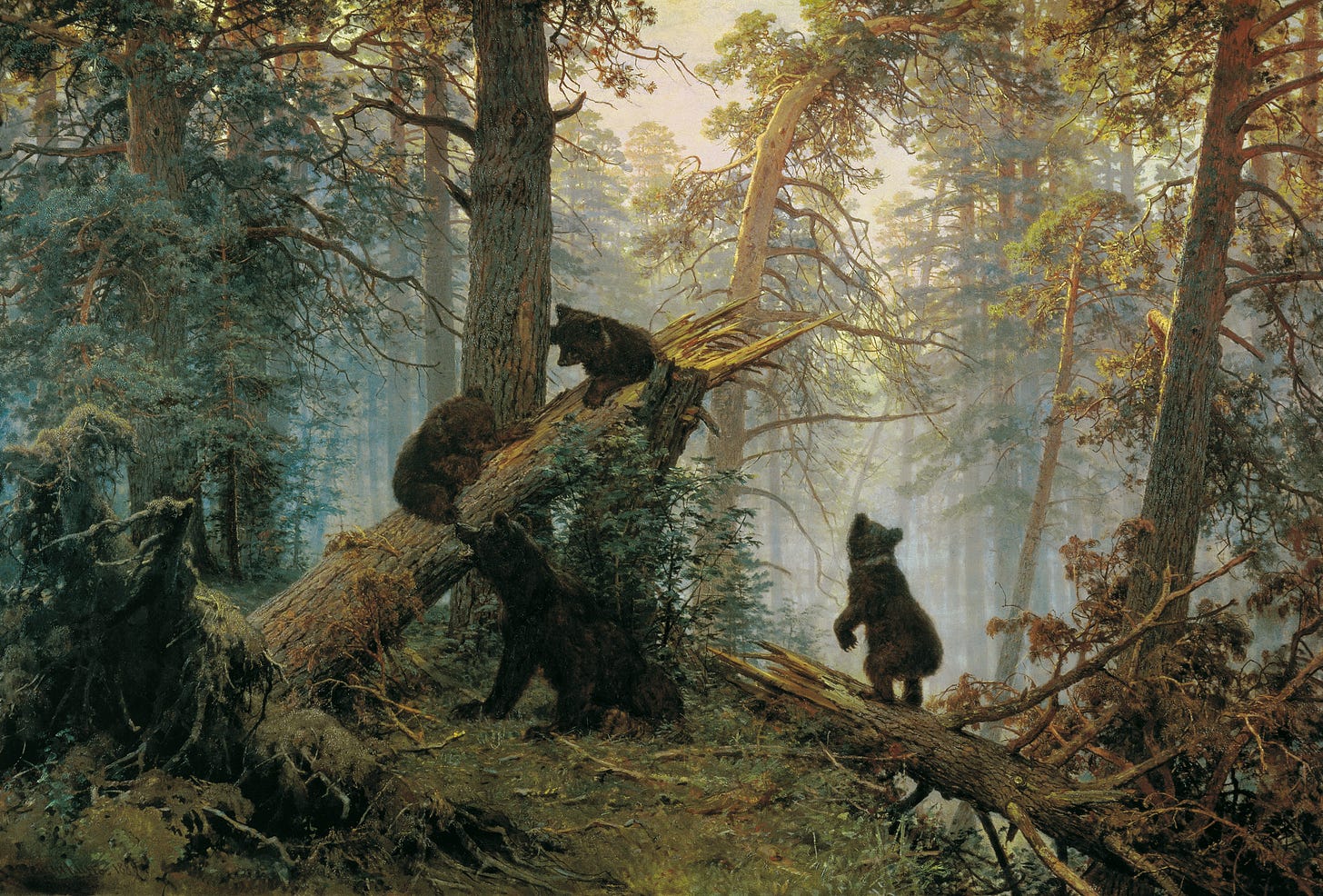
Here is video showing Geddi trying and failing to drink water from the tap. It took him days to figure out he has to lap at it, not bite it—you’d think a cat would know that innately. That criteria can be used to explain different states of matter, i.e., solids you can bite, liquids you can’t.
This essay would not be complete without mentioning two cats who are no longer with us. Here is Sidor, my first cat ever.
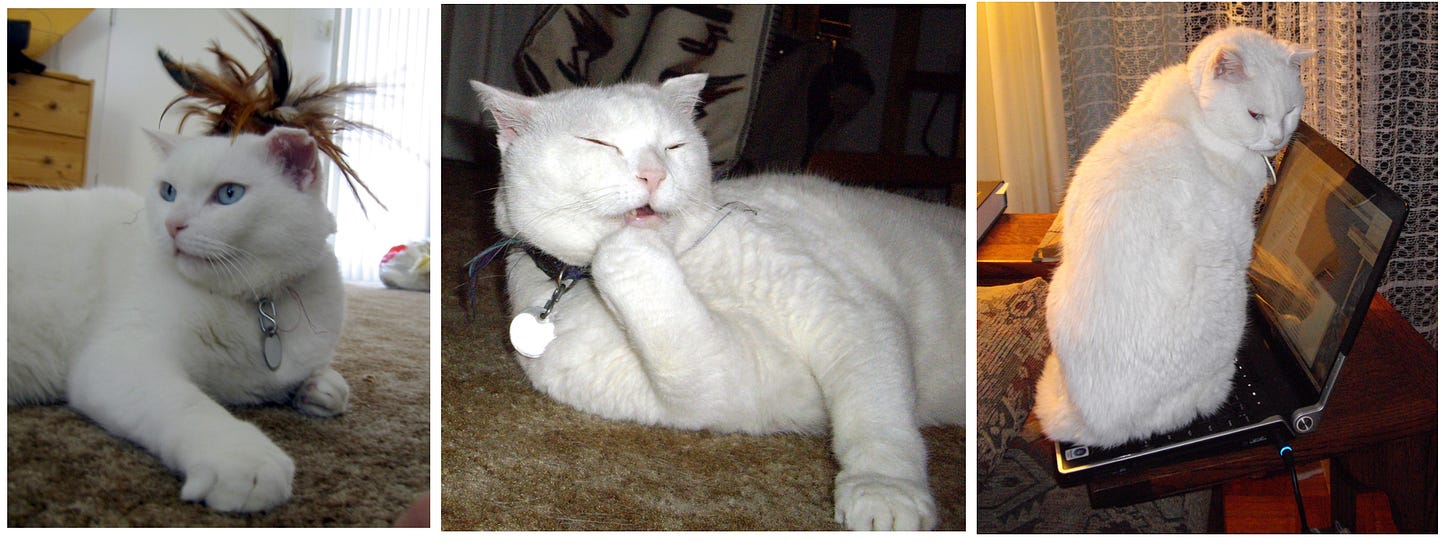
Sidor was a stray who had been picked up off the street in Jerusalem. He came with excellent recommendations from my colleague, friend, and mentor, Professor Victoria Buch [24] (who passed away much too young, losing a battle with cancer). Victoria had been feeding strays around her house (there are many feral cats in Israel) and was taken by his calm, composure, and quiet friendliness. She told me she loved this cat, but could not bring him home, because she already had several and—as she put it—taking in another one would have pushed her family over the edge. So I [Anna] took him in instead, and within a week he became the emotional center of the household—in terms of attention, love, and admiration. Sidor had a unique way of gracefully accepting human attention of any kind. He was not attention-seeking, but would allow humans to express their admiration for him with the same noble grace that Queen Elizabeth allowed her subjects to adore her. You could put Sidor on your lap and he would stay there purring. He would allow children to dress him, roll him around, carry him around the house, play with him, etc. I do not recall him ever trying to walk away or hide from anyone. Sidor also made a name for himself at the vet—he would always purr during examinations, no matter what the procedure was.
Sidor left a mark on many hearts. After I left Israel, the first question that my friends would ask me when we would get together after a few years would be “How’s Sidor doing?” And only after that question was answered, would the conversation move on to less significant topics—whether I am still married to the same guy, how is my daughter doing, what is going on at work, and so on. When I saw Victoria in 2009, just a few months before she passed away, we talked about life, science, and Sidor.
How did Sidor get his name? Sidor is a Russian name, archaic and uncommon. So here is the story. Inspired by his magnificent white coat, we tried Snowball, Snow-white, and variations around these themes, but nothing stuck.
Back then, my former husband, Dmitri, and I were obsessed with Sergey Dovlatov’s [25] novels and would often recite quotes from them. One line that Dmitri often quoted was from Pushkin Hills (Заповедник) [26], an autobiographical novel in which Dovlatov talks about his work at Pushkin’s museum and candidly describes the locals. The line is an obscene string of words without much meaning that an old villager (Dovlatov’s landlord) would often utter. Dovlatov compares it to abstract poetry—it communicates the mood, but does not carry concrete meaning: “Это сидор-пидор бозна де...” Among the mix of barely recognizable words and clearly recognizable profanity, the word “Sidor” stands out, and that stuck.
Sidor had a long happy life and traveled the world, living in Jerusalem, Washington DC, the Bay area, and Southern California. He traveled by car and plane with his usual quiet grace—only after we adopted our second cat, Ryzhy, did I realize that cats, as a rule, do not make good automobile passengers.
When I started my assistant professorship at USC, we adopted a kitten from a friend to provide Sidor with a playmate. Again, finding a name took some time, and we ended up with a not very creative but very descriptive one: Ryzhy (Рыжий, red-hair in Russian).
Ryzhy and Sidor became buddies from the first day, and Ryzhy became very depressed when Sidor eventually died.
Sidor was so special that, after he died, we wanted to get a cat that would have something in common with him. We suspected that Sidor had been part British Shorthair and thought another Brit would make a good companion for Ryzhy so we went to a breeder and got a British Blue Shorthair kitten, Mishka.

When we brought Mishka in, Ryzhy first resented him, but eventually they bonded through shared hardship on a long a car trip to Boulder, Colorado, where we spent several months on sabbatical.
The relationship between cats and scholars have been celebrated in art and poetry. The Irish poem Pangur Ban [27], which dates back to the 8th or 9th century celebrates the synergy between cats and the scholars they own. Below is an adaptation of Pangur Ban by W.H. Auden:
The Monk and His Cat
Pangur, white Pangur,
How happy we are
Alone together, Scholar and cat.
Each has his own work to do daily;
For you it is hunting, for me, study.
Your shining eye watches the wall;
My feeble eye is fixed on a book.
You rejoice when your claws entrap a mouse;
I rejoice when my mind fathoms a problem.
Pleased with his own art
Neither hinders the other;
Thus we live ever
Without tedium and envy.
Pangur, white Pangur,
How happy we are,
Alone together, Scholar and cat.
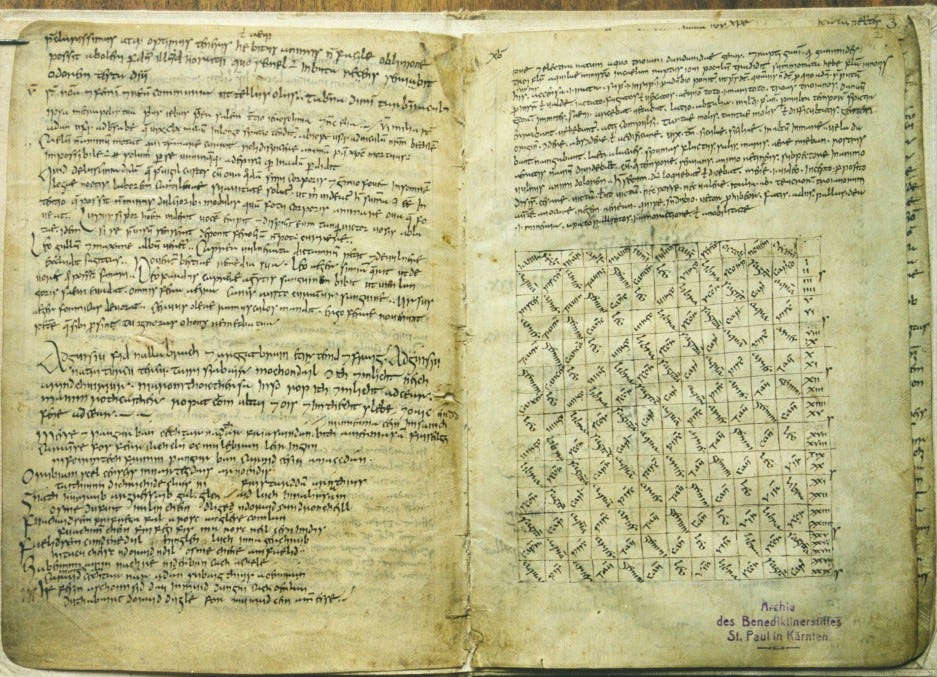
There are multiple translations and adaptations of Pangur Ban [27], including these two lovely Russian translations [28], which we reproduce in the Appendix below.
The 18th century painting below, depicting monks relaxing around the fire, after a day full of devotions, documents the importance of cats in the life of a scholar. The life of modern-day academics can be tough and full of hardship and sacrifice, but the cats make it worth living.
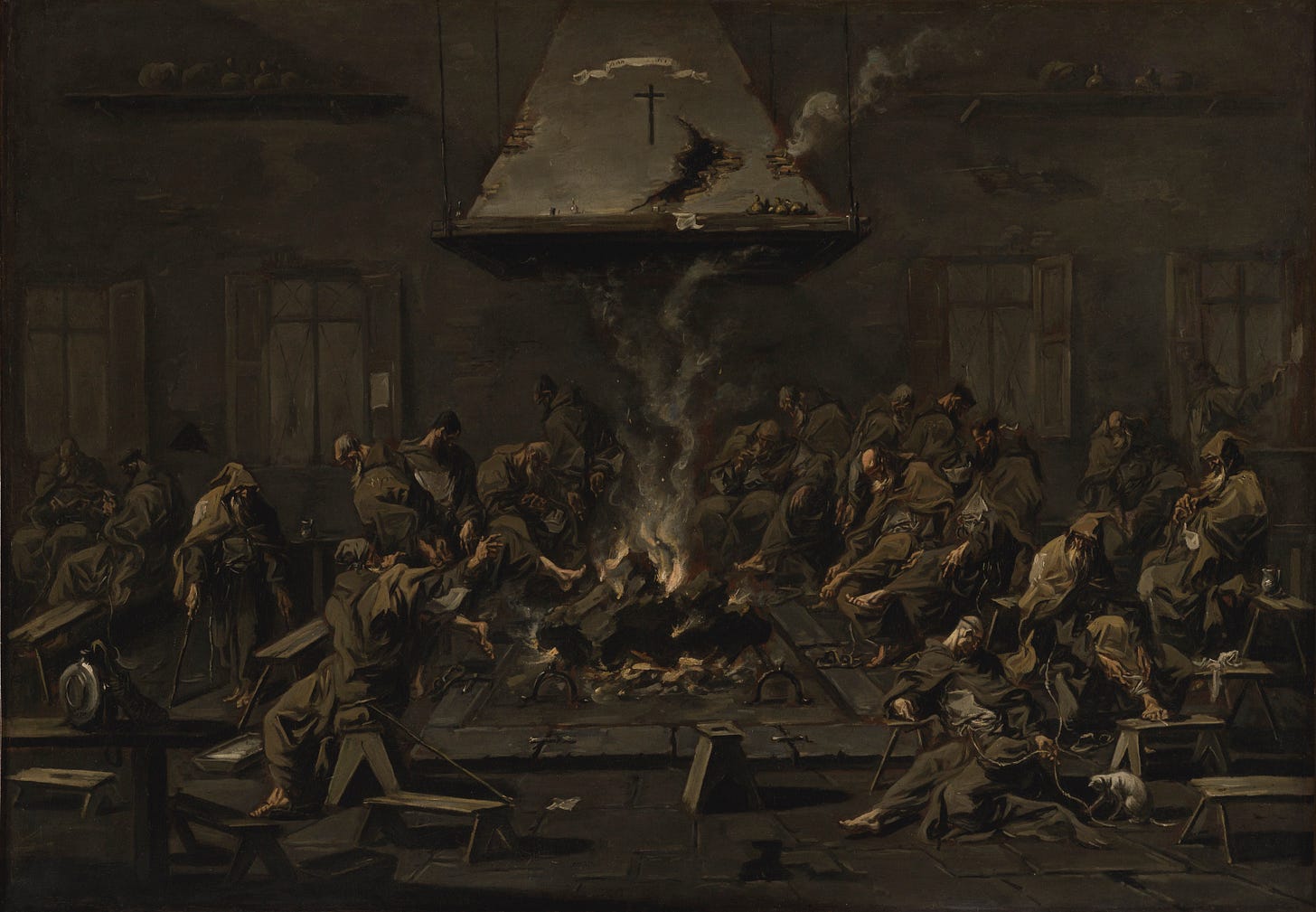
Credits and acknowledgements
1. No cats were harmed or inconvenienced through this work.
2. Anna’s collaborators on these papers [13,15,16], who contributed to developing the ideas of the graphics.
3. Dr. Pavel Pokhilko used cats to illustrate effective Hamiltonians in his Ph.D. thesis [29].
4. Artist who draw the pictures: Sonja Gerard.
5. Professor David Clary from Oxford University for his comments on this essay.
6. Dmitri Krylov for pointing out to Russian translations [28] of Pangur Ban.
7. Natalie Orms and Anastasia Gunina for providing photographs of the cat art pictures and for occasional cat-sitting.
8. Cats from the Krylov and Tanzman household—Mishka and Geddi—for their inspiration and emotional support.
9. Cover gallery from Anna’s group [30].
Appendix: Russian translations of Pangur Ban: Белый Пангур
Перевод В.А. Заславского:
Забыл о славе я мирской
Ради уютной кельи
И Пангур белоснежный мой,
Со мной призванье делит.
И нет ни ссор, ни суеты,
Ни зависти меж нами.
И кот, и я увлечены
Любимыми делами.
Своим трудом я поглощен,
Святой наукой книжной.
И полон кот своих забот:
Его наука – мыши.
Врагу устроив западню,
Ко мне он мышь приносит.
А я – в сеть разума ловлю
Научные вопросы.
Пытлив и скор, кот вперил взор
В нору, где мышь таится.
Мои ж глаза глядят всегда
На книжные страницы.
Мой Пангур весело мурчит,
Когда добычу словит.
Я так же радуюсь, решив
Проблему в богословьи.
Сидим с котом мы за трудом,
Друг другу не мешаем,
Хоть занят я борьбой с грехом,
А кот – борьбой с мышами.
Отдам коту свою еду,
Свои печаль и радость.
И так вдвоем в ладу живем:
Монаху друг не в тягость.
Перевод Г. Кружкова:
С белым Пангуром моим
вместе в келье мы сидим,
не докучно нам вдвоём:
всяк при деле при своём.
Я прилежен к чтению,
книжному учению,
Пангур иначе учён:
он мышами увлечён.
Слаще в мире нет утех:
без печали, без помех,
упражняться не спеша
в том, к чему лежит душа.
Всяк из нас в одном горазд:
зорок он и я глазаст;
мудрено и мышь поймать,
мудрено и мысль понять.
Видит он, сощуря глаз,
под стеной мышиный лаз.
Взгляд мой видит вглубь строки:
бездны знаний глубоки.
Весел он, когда в прыжке,
мышь насигнет в уголке,
весел я, как в сеть свою,
суть премудру уловлю.
Можно днями напролёт
жить без горя и забот,
коли есть полезное
ремесло любезное.
Кот привык и я привык -
враждовать с врагами книг;
всяк из нас своим путём:
он - охотой, я - письмом.
References
1. J. Coyne, Caturday Felid Trifecta, Why Evolution is True.
2. J. Coyne, Cats Who Owned Famous Scientists and Ten Cats in Literature, Why Evolution is True (2022).
3. Wikipedia article about Erwin Schrödinger.
4. E. Schrödinger, Quantisierung als Eigenwertproblem, Annalen der Physik. 384 273 (1926).
5. “The fundamental laws necessary for the mathematical treatment of a large part of physics and the whole of chemistry are thus completely known, and the difficulty lies only in the fact that application of these laws leads to equations that are too complex to be solved. It therefore becomes desirable that approximate practical methods of applying quantum mechanics should be developed, which can lead to an explanation of the main features of complex atomic systems without too much computation.” P. Dirac, 1929.
6. The Nobel Prize in Physics in 1933: The announcement.
7. E. Schrödinger, Die gegenwärtige Situation in der Quantenmechanik (The present situation in quantum mechanics). Naturwissenschaften 23 807 (1935); Translation: J.D. Trimmer, The Present Situation in Quantum Mechanics: A Translation of Schrödinger’s “Cat Paradox” Paper. Proceedings of the American Philosophical Society, 124 323 (1980).
8. Wikipedia article about Schrödinger’s Cat Paradox.
9. D.C. Clary, Schrödinger in Oxford, WSPC (2022).
10. Wikipedia article about M.C. Escher.
11. Schrödinger’s Cat magazine.
12. Schrödinger’s Cat gallery by Kirill Zatrimailov.
13. A. E. Clark, H. Adams, R. Hernandez, A. I. Krylov, A. M. N. Niklasson, S. Sarupria, Y. Wang, S. M. Wild, and Q. Yang, The Middle Science: Traversing scale in complex many-body systems, ACS Central Sci. 7 1271 (2021).
14. R.P. Feynman, Simulating physics with computers, Int. J. Theor. Phys. 21 467 (1982).
15. A.I. Krylov, J. Doyle, and K.-K. Ni, Quantum computing and quantum information storage: An introduction, Phys. Chem. Chem. Phys. 23 6341 (2021).
16. J. A. Andersen, K. D. Nanda, A. I. Krylov, and S. Coriani, Probing molecular chirality of ground and electronically excited states in the UV–vis and X-ray regimes: An EOM-CCSD study, J. Chem. Theo. Comp. 18 1748 (2022).
17. Wikipedia article about chirality.
18. A. Gunina, Ph.D. thesis: Photoionization/photodetachment spectroscopy and Dyson orbitals: theoretical tools to aid experimental studies.
19. N. Orms, Ph.D. thesis: Electronic structure analysis of challenging open-shell systems: from excited states of copper oxide anions to exchange-coupling in binuclear copper complexes.
20. D. Casanova and A. I. Krylov, Spin-flip methods in quantum chemistry, Phys. Chem. Chem. Phys. 22 4326 (2020).
T.S. Elliot, The naming of cats, in Old possum’s book of practical cats, Faber & Faber, London (1939).
What people named their cats in the Middle Ages: Gyb, Mite, Méone, Pangur Bán & more, Open Culture (2023).
23. Wikipedia article about Shishkin’s painting “Morning in a pine forest” (“Утро в сосновом лесу”).
24. Victoria Buch’s website at the Hebrew University of Jerusalem; see also R.B. Gerber, Tributes to Victoria Buch, J. Phys. Chem. A 115 5709 (2011).
25. Wikipedia article about Sergei Dovlatov.
26. S. Dovlatov, Pushkin Hills (Заповедник), 1983 (trans. Berkeley, CA: Counterpoint, 2014).
Wikipedia article about Pangur Ban. The article mentions multiple translations and adaptations.
Монах и его кот, Russian Translations of Pangur Ban, Facetiae.
29. P. Pokhilko, Ph.D. thesis: Development and application of robust many-body methods for strongly correlated systems: From spin-forbidden chemistry to single-molecule magnets.
30. iOpenShell cover gallery.




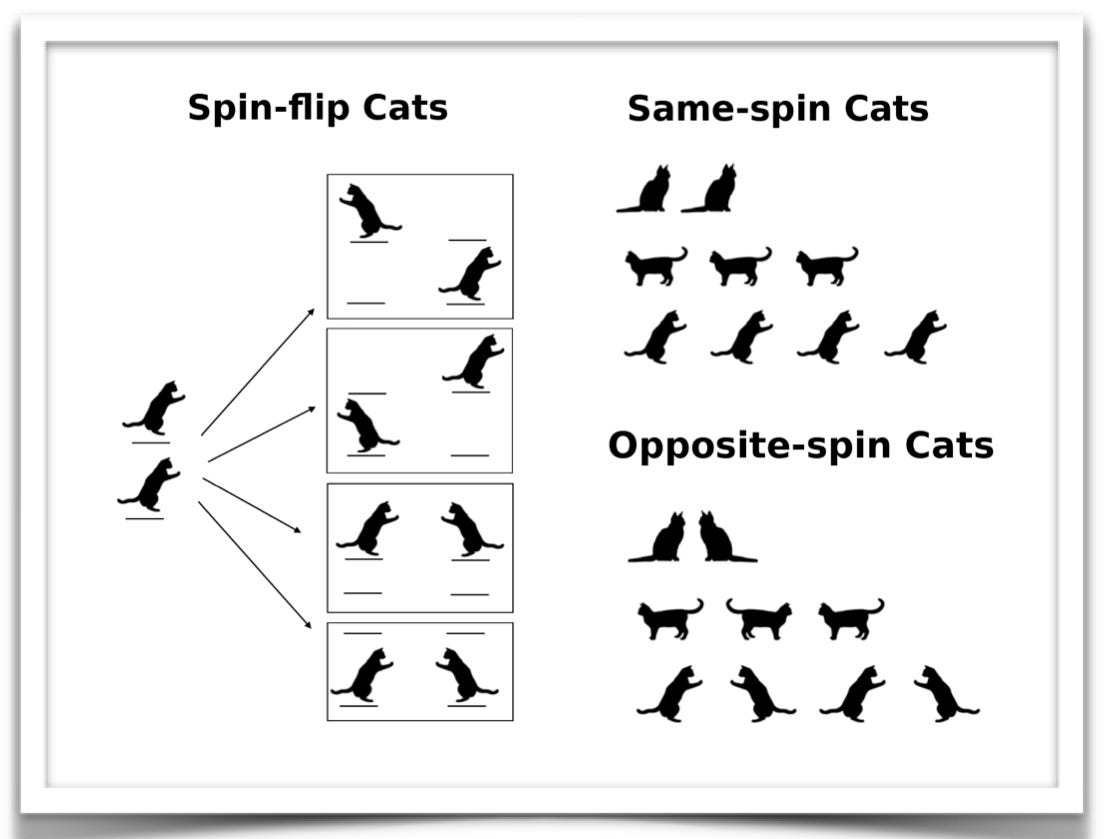
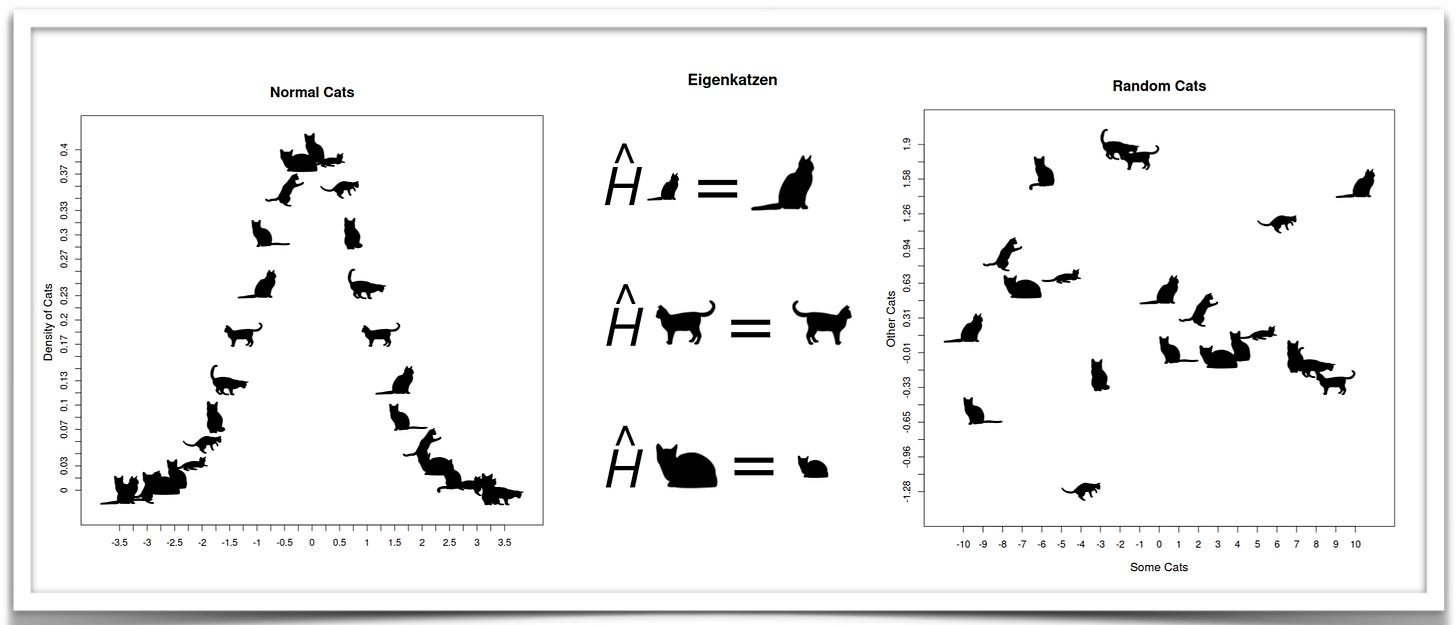
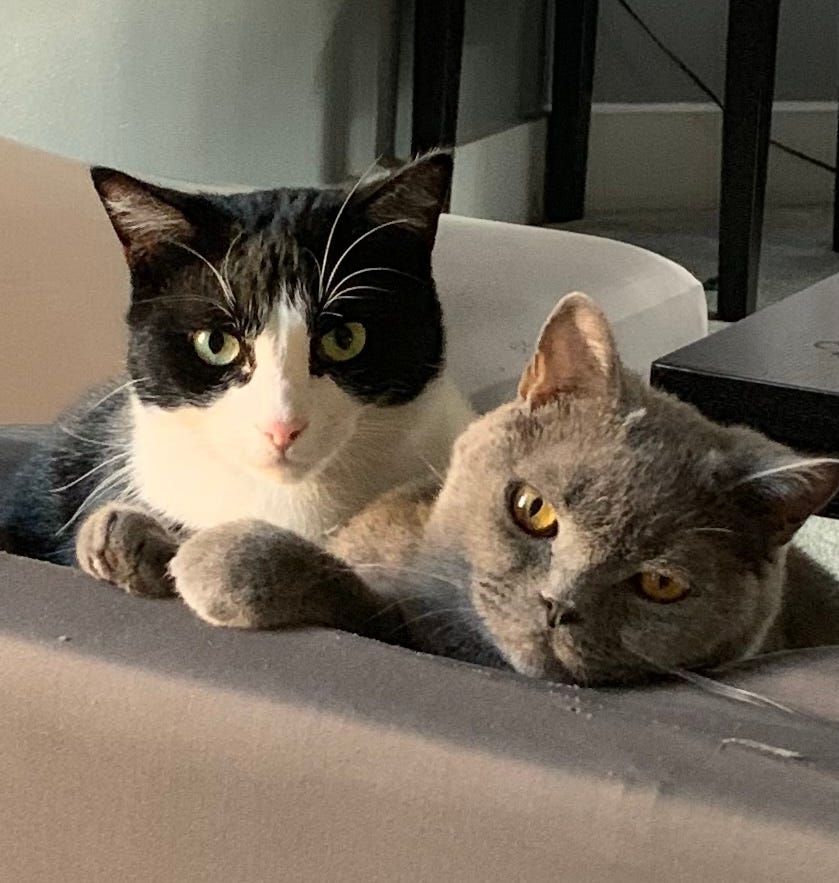




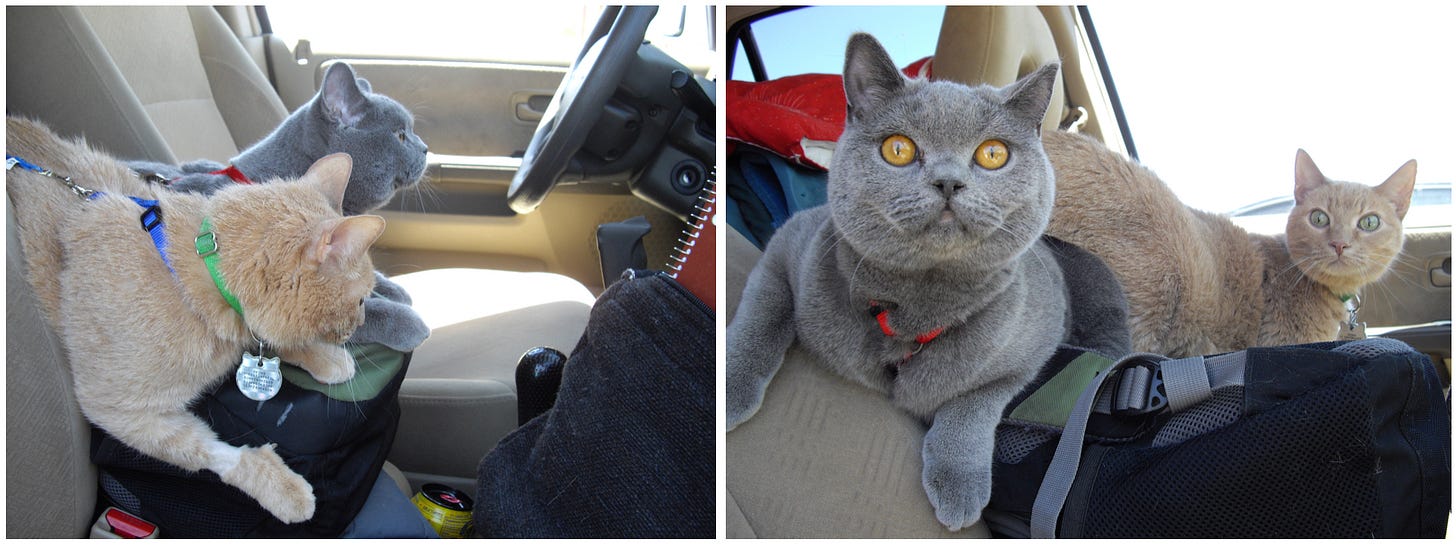

And here is one more cover art with cats:
https://pubs.acs.org/doi/10.1021/acs.jpca.3c02480
You can also see the image here:
https://iopenshell.usc.edu/pubs/covers/
There are more quantum cats out there: <iframe src="https://www.facebook.com/plugins/post.php?href=https%3A%2F%2Fwww.facebook.com%2Fanna.krylov%2Fposts%2Fpfbid02pR29N9ERjV1YGpbrGFg6ypiB6B5j2c249dzVr89MLjebdZZNrus5x1GRYdA37Uppl&show_text=true&width=500" width="500" height="832" style="border:none;overflow:hidden" scrolling="no" frameborder="0" allowfullscreen="true" allow="autoplay; clipboard-write; encrypted-media; picture-in-picture; web-share"></iframe>